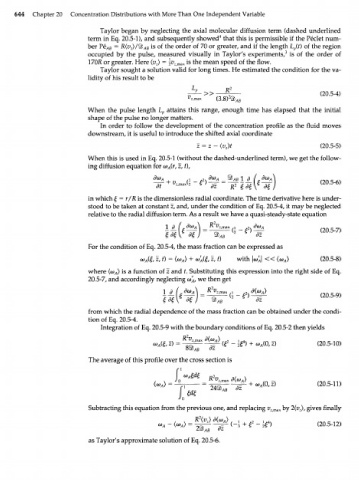Page 664 - Bird R.B. Transport phenomena
P. 664
644 Chapter 20 Concentration Distributions with More Than One Independent Variable
Taylor began by neglecting the axial molecular diffusion term (dashed underlined
4
term in Eq. 20.5-1), and subsequently showed that this is permissible if the Peclet num-
ber Pe AB = R{v )/4b AB is of the order of 70 or greater, and if the length L (t) of the region
p
z
3
occupied by the pulse, measured visually in Taylor's experiments, is of the order of
170R or greater. Here (v ) = \v zmax is the mean speed of the flow.
z
Taylor sought a solution valid for long times. He estimated the condition for the va-
lidity of his result to be
L,
(20.5-4)
2
(3.8) О) лв
When the pulse length L p attains this range, enough time has elapsed that the initial
shape of the pulse no longer matters.
In order to follow the development of the concentration profile as the fluid moves
downstream, it is useful to introduce the shifted axial coordinate
2 = 2 - (v )t (20.5-5)
z
When this is used in Eq. 20.5-1 (without the dashed-underlined term), we get the follow-
ing diffusion equation for o) (r, z, t),
A
at
in which £ = r/R is the dimensionless radial coordinate. The time derivative here is under-
stood to be taken at constant z, and, under the condition of Eq. 20.5-4, it may be neglected
relative to the radial diffusion term. As a result we have a quasi-steady-state equation
a<* A
(2a5 7)
"
For the condition of Eq. 20.5-4, the mass fraction can be expressed as
4<(£ 2, t) = (o) A) + (o' A(£, 2, t) with \<o A\ « (o) A) (20.5-8)
where (o) A) is a function of z and t. Substituting this expression into the right side of Eq.
20.5-7, and accordingly neglecting <D' A, we then get
from which the radial dependence of the mass fraction can be obtained under the condi-
tion of Eq. 20.5-4.
Integration of Eq. 20.5-9 with the boundary conditions of Eq. 20.5-2 then yields
2
°r~ (£ " \?) + "л(0, z) (20.5-10)
The average of this profile over the cross section is
5
W = — = -2^ -ж- + шЖ z) (20 - - n)
•'о
Subtracting this equation from the previous one, and replacing v z/max by 2(v ), gives finally
z
^A ~ \^A) — ~^ ~jF~ v з + ь "" ГГ) ии.э-lz;
as Taylor's approximate solution of Eq. 20.5-6.

